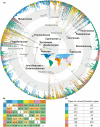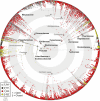Global analysis of Poales diversification - parallel evolution in space and time into open and closed habitats
- PMID: 38009920
- PMCID: PMC11497318
- DOI: 10.1111/nph.19421
Global analysis of Poales diversification - parallel evolution in space and time into open and closed habitats
Abstract
Poales are one of the most species-rich, ecologically and economically important orders of plants and often characterise open habitats, enabled by unique suites of traits. We test six hypotheses regarding the evolution and assembly of Poales in open and closed habitats throughout the world, and examine whether diversification patterns demonstrate parallel evolution. We sampled 42% of Poales species and obtained taxonomic and biogeographic data from the World Checklist of Vascular Plants database, which was combined with open/closed habitat data scored by taxonomic experts. A dated supertree of Poales was constructed. We integrated spatial phylogenetics with regionalisation analyses, historical biogeography and ancestral state estimations. Diversification in Poales and assembly of open and closed habitats result from dynamic evolutionary processes that vary across lineages, time and space, most prominently in tropical and southern latitudes. Our results reveal parallel and recurrent patterns of habitat and trait transitions in the species-rich families Poaceae and Cyperaceae. Smaller families display unique and often divergent evolutionary trajectories. The Poales have achieved global dominance via parallel evolution in open habitats, with notable, spatially and phylogenetically restricted divergences into strictly closed habitats.
Keywords: biogeography; evolution; evolutionary transitions; grasslands; grass‐like plants; savannas; spatial phylogenetics.
© 2023 The Authors New Phytologist © 2023 New Phytologist Foundation.
Conflict of interest statement
None declared.
Figures





References
-
- Andrino CO, Costa FN, Simon MF, Missagia RV, Sano PT. 2023. Eriocaulaceae: a new classification system based on morphological evolution and molecular evidence. Taxon 72: 515–549.
-
- APG IV . 2016. An update of the Angiosperm Phylogeny Group classification for the orders and families of flowering plants: APG IV. Botanical Journal of the Linnean Society 181: 1–20.
-
- Attigala L, Wysocki WP, Duvall MR, Clarke LG. 2016. Phylogenetic estimation and morphological evolution of Arundinarieae (Bambusoideae: Poaceae) based on plastome phylogenomic analysis. Molecular Phylogenetics and Evolution 101: 111–121. - PubMed
-
- Bailey SF, Blanquart F, Bataillon T, Rees K. 2017. What drives parallel evolution? How population size and mutational variation contribute to repeated evolution. BioEssays 39: 1–9. - PubMed
MeSH terms
Grants and funding
LinkOut - more resources
Full Text Sources

